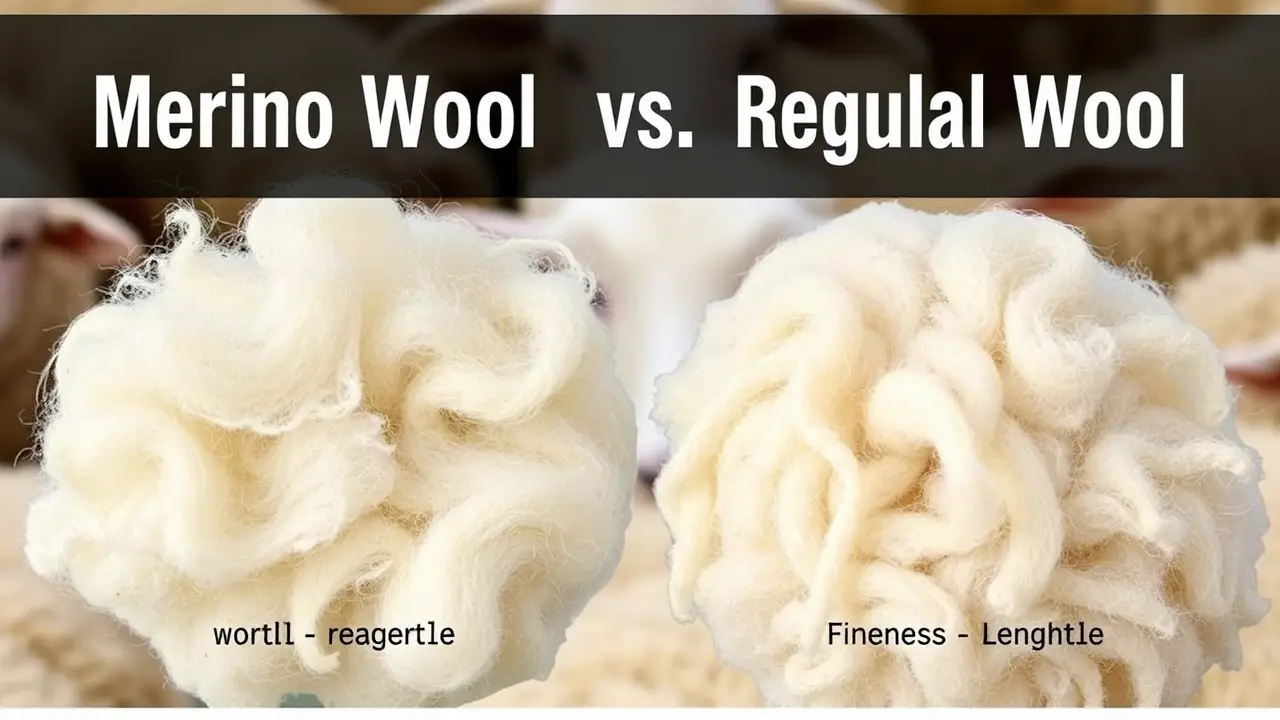Merino wool is often considered warmer than regular wool due to its unique properties. Merino wool comes from Merino sheep, which are known for their fine, soft, and highly crimped wool fibers.
Difference Between Merino Wool And Regular Wool
- Source: Merino wool comes specifically from Merino sheep, which are bred for their high-quality wool. Regular wool can come from various breeds of sheep, as well as other animals like goats (e.g., cashmere) or rabbits (e.g., angora).
- Fiber Diameter: Merino wool has much finer fibers compared to regular wool. The diameter of Merino wool fibers is typically smaller, which contributes to its softness and comfort against the skin.
- Softness: Due to the smaller fiber diameter and unique crimp structure, Merino wool is generally considered softer and more luxurious compared to regular wool. It can be comfortably worn directly against the skin without causing itching or irritation.
- Insulation: Merino wool has exceptional insulating properties. The fine fibers and natural crimp of Merino wool create small air pockets that trap heat and provide effective insulation. Regular wool also offers insulation but may vary in quality and performance depending on the specific breed and processing.
- Moisture Management: Merino wool has excellent moisture-wicking capabilities. It can absorb moisture from the body and release it into the atmosphere, keeping the wearer dry and comfortable. Regular wool has some moisture-wicking properties as well but may not be as effective as Merino wool in managing moisture.
- Breathability: Merino wool is highly breathable, allowing air to circulate through the fabric and regulate body temperature. It helps to keep you warm in cold weather and cool in warm conditions. Regular wool can also be breathable but may not provide the same level of breathability as Merino wool.
- Odor Resistance: Merino wool has natural antimicrobial properties, meaning it can resist the buildup of odor-causing bacteria. This makes it suitable for activities where you may sweat or wear the garment for an extended period. Regular wool may also have some odor resistance, but Merino wool is often preferred in this regard.
The Marvel of Merino Wool

- Fineness: Merino wool has incredibly fine fibers, making it soft and comfortable to wear against the skin.
- Insulation: The small diameter and crimp of Merino wool fibers create excellent insulation by trapping air, providing warmth in cold weather.
- Breathability: Merino wool is highly breathable, allowing air to circulate and regulate body temperature, keeping you cool in warm conditions.
- Moisture Management: Merino wool has excellent moisture-wicking properties, absorbing sweat and releasing it into the atmosphere, keeping you dry and comfortable.
- Odor Resistance: The natural antimicrobial properties of Merino wool make it resistant to odor-causing bacteria, ensuring freshness even after prolonged use.
- Temperature Regulation: Merino wool adapts to your body’s temperature fluctuations, keeping you warm when it’s cold and cool when it’s hot.
- Durability: Merino wool is known for its durability, making it long-lasting and resistant to wear and tear.
- UV Protection: Merino wool offers inherent protection against harmful ultraviolet (UV) rays, shielding your skin from the sun’s harmful effects.
- Easy Care: Merino wool is relatively easy to care for, as it is naturally stain-resistant, anti-wrinkle, and can often be machine washed.
- Sustainable and Renewable: Merino wool is a renewable resource as sheep grow new wool each year. It is also biodegradable and eco-friendly.
- Versatility: Merino wool can be used in various types of clothing and accessories, including base layers, sweaters, socks, hats, and more.
- Softness and Comfort: Merino wool’s fine fibers and natural elasticity provide exceptional softness and comfort, making it a pleasure to wear.
- Allergy-Friendly: Merino wool is hypoallergenic for many people, as it does not contain lanolin, a common allergen found in other types of wool.
Unraveling Regular Wool
- Variety: Regular wool can come from various breeds of sheep, as well as other animals like goats (e.g., cashmere), rabbits (e.g., angora), or llamas (e.g., llama wool).
- Insulation: Regular wool provides insulation due to its natural crimp and ability to trap air, keeping you warm in cold weather.
- Breathability: Wool is generally breathable, allowing air to circulate through the fabric and help regulate body temperature.
- Moisture Management: Wool has some moisture-wicking properties, absorbing moisture from the body and releasing it into the atmosphere. It can help keep you dry and comfortable.
- Durability: Wool is known for its durability and can withstand wear and tear, making it a long-lasting material.
- Odor Resistance: Wool has inherent odor-resistant properties, thanks to its ability to naturally repel and inhibit the growth of odor-causing bacteria.
- Flame Resistance: Wool is naturally flame-resistant and has a high ignition temperature, making it less likely to catch fire compared to other materials.
- All-Weather Performance: Wool can provide warmth in cold weather and can also help regulate body temperature in warmer conditions, making it suitable for various climates.
- Moisture Absorption: Wool can absorb moisture up to 30% of its weight without feeling damp, helping to keep you dry in damp or humid environments.
- Insulating Even When Wet: Wool retains its insulation properties even when it gets wet, unlike some synthetic materials.
- Versatility: Regular wool can be used in a wide range of clothing and accessories, including sweaters, blankets, scarves, and socks.
- Natural and Sustainable: Wool is a renewable and biodegradable resource, making it an eco-friendly choice.
- Itchiness: Some people may find regular wool slightly itchy or irritating against the skin, depending on the specific type and quality of wool.
Warmth Metrics: Comparing Merino Wool and Regular Wool
When comparing the warmth of Merino wool and regular wool, it’s essential to consider several metrics:
- Fiber Diameter: Merino wool typically has finer fibers compared to regular wool. The smaller diameter of Merino wool fibers allows for better insulation and heat retention.
- Insulation: Both Merino wool and regular wool provide insulation due to the natural crimp of the fibers, which helps trap air and create a layer of warmth. However, Merino wool’s finer fibers often result in more effective insulation.
- Weight: The weight of the fabric can impact its warmth. Merino wool garments tend to be lighter in weight while still providing excellent insulation, making them a good choice for layering.
- Moisture Management: Merino wool’s superior moisture-wicking properties can help regulate body temperature and keep you warm even when damp. Regular wool also has moisture-wicking capabilities but may not be as efficient as Merino wool.
- Breathability: Both Merino wool and regular wool are breathable, allowing moisture and excess heat to escape. This helps prevent overheating and keeps you comfortable in various temperatures.
- Layering: Merino wool’s softness and fine texture make it an excellent base layer for trapping warmth close to the body. Regular wool can also be used for layering, but its coarser texture may be less comfortable against the skin.
- Outdoor Performance: Merino wool is highly regarded for its warmth-to-weight ratio and ability to keep you warm in cold conditions. It is a popular choice for outdoor enthusiasts and athletes. Regular wool can provide warmth as well, but the specific type and quality can vary.
- Personal Preference: Warmth is subjective, and individual preferences may vary. Some people may find Merino wool to be warmer due to its finer fibers, while others may find regular wool sufficient for their warmth needs.
It’s worth noting that warmth also depends on factors like the thickness of the fabric, the specific breed of sheep or animal, and the manufacturing techniques used. It’s recommended to check the specific product’s details and customer reviews for a better understanding of its warmth performance.
Conclusion
In conclusion, Merino wool is often considered warmer than regular wool due to its finer fibers, superior insulation properties, and excellent moisture management. The smaller diameter of Merino wool fibers allows for better heat retention and insulation, making it an ideal choice for warmth in cold conditions. Additionally, Merino wool’s moisture-wicking capabilities and breathability help regulate body temperature and keep you comfortable in varying weather conditions.

